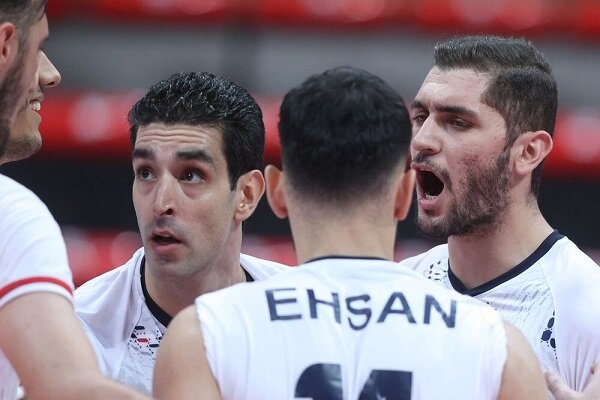Volleyball is played with six players on each side. In this fast-paced sport, each team aims to gain points by hitting the ball over the net and into the opponent’s court.
Volleyball, a game known for its fast-paced action, requires six players on each team. It involves two teams vying for points by hitting the ball over the net and into the opposing team’s court. With strategic positioning and teamwork, players must work together to set up successful attacks and prevent the opposition from scoring.
Volleyball is a popular sport worldwide, both as a recreational activity and as a competitive game at the professional level. Whether played indoors or outdoors, the game demands agility, coordination, and strong communication among team members. Let’s explore the rules, techniques, and dynamics of this thrilling sport in more detail.

Credit: en.mehrnews.com
The Role Of Players In Volleyball
In volleyball, the number of players on a team varies, depending on the level of play. In general, a volleyball team is made up of six players on the court at a time. Each player on the team has specific roles and responsibilities, contributing to the overall success of the team.
The key positions in a volleyball team include:
| Position | Role |
|---|---|
| Setter | The setter is responsible for setting the ball for hitters to attack. They play a crucial role in coordinating the team’s offense. |
| Outside Hitter | Outside hitters are primary attackers and are responsible for both offensive and defensive plays. |
| Opposite Hitter | The opposite hitter plays on the opposite side of the setter and is usually the second primary attacker. |
| Middle Blocker | Middle blockers play a dual role of blocking and attacking. They are positioned in the middle of the net. |
| Libero | The libero is a defensive specialist responsible for receiving serves and helping with defensive plays. |
| Defensive Specialist | The defensive specialist, similar to the libero, focuses on defensive plays and receiving serves. |
Each player on the court has specific responsibilities that contribute to the success of the team. These responsibilities include communication, teamwork, positioning, serving, receiving, attacking, blocking, and digging. It is through the combined efforts of all players that a volleyball team can achieve victory.
The Number Of Players In A Volleyball Team
When it comes to volleyball, the number of players on a team can vary depending on the level of play and the type of game being played. In a standard indoor volleyball match, both teams consist of six players on the court at a time, with three players in the front row and three in the back row. The player rotation occurs when the team gains the serve, and each player moves clockwise to the next position. This rotation system ensures that each player has an opportunity to play in different positions.
In addition to the six players on the court, most teams have substitutes waiting on the bench. These substitutes can be brought into the game to replace a player, providing an opportunity for rest or tactical changes. Player substitutions have a significant impact on team dynamics, as it allows coaches to make strategic decisions based on the flow of the game and the strengths of individual players.
Overall, having the right number of players and utilizing substitutions effectively is crucial in volleyball. It ensures that teams have the necessary manpower and flexibility to compete at their best and adapt to different game situations.
The Importance Of Team Composition In Volleyball
Important: Please bold the following phrases and sentences Volleyball team composition is crucial in determining the success of a match. A well-balanced team ensures that players with specific skills and positions work together effectively. Each player’s role contributes to the overall strategy and coordination on the court. In volleyball, the team is typically divided into six positions: setters, opposites, outside hitters, middle blockers, liberos, and defensive specialists. The setter is responsible for coordinating the team’s offense and distributing the ball to the hitters. The opposite is the primary attacker opposite the setter. Outside hitters and middle blockers are crucial for both blocking and attacking. Liberos specialize in defensive plays and seamless reception, while defensive specialists focus on passing and serve-receive. By having a diverse range of skills and specialties, players can complement each other effectively and contribute to the team’s success. The collective efforts of each player create a well-rounded and dynamic team, capable of outperforming opponents.
Analyzing The Benefits Of Different Team Sizes
The number of players in a volleyball team greatly impacts the dynamics and strategy of the game. Having a smaller team can offer various advantages. Firstly, with fewer players, communication and coordination become more efficient as there are fewer individuals to communicate with and fewer potential miscommunications. Additionally, a smaller team allows for more playing time for each player, fostering skill development and enhancing individual strengths. Moreover, a smaller team can create a strong bond and camaraderie among players, leading to better teamwork and cohesion on the court. Conversely, a larger team brings its own set of benefits. It allows for more substitution options, enabling players to rest and recover during demanding matches. Furthermore, a larger team can offer more diverse skill sets and strategies, providing flexibility and adaptability to different game situations. Ultimately, the choice of team size depends on the specific goals and dynamics of the team, as both smaller and larger teams have their own unique advantages in the game of volleyball.
Strategies For Adjusting Team Dynamics
When it comes to volleyball, team dynamics play a crucial role in a team’s success. Strategies for adjusting team dynamics become even more important when players are unavailable or injured. Teams need to adapt and make modifications in their strategies to accommodate different team sizes.
One approach to managing the absence of players is by redistributing responsibilities within the team. Assigning additional roles to existing players can help fill the gaps and maintain the team’s performance. It is essential to analyze the strengths and weaknesses of each player and adjust playing positions accordingly.
Another strategy is to focus on effective communication and teamwork. Teams should emphasize the importance of clear communication and coordination, especially in high-pressure situations. Improving communication channels and building trust among team members can help compensate for a reduced number of players.
Additionally, maintaining a positive team morale is crucial during challenging times. Encouraging and supporting each other can boost team spirit and motivation. Coaches and team leaders play a vital role in keeping the team united and motivated despite the setbacks.
In conclusion, when facing challenges due to unavailable or injured players, adjusting team dynamics is crucial. By redistributing responsibilities, emphasizing effective communication, and fostering team morale, teams can adapt and continue to perform at their best.
Maximizing Team Performance Through Cohesion
| Maximizing Team Performance Through Cohesion | |
| The significance of communication and collaboration in volleyball teams | Techniques to enhance team coordination and chemistry |
|
Communication and collaboration are vital aspects of success in volleyball teams. Effective communication helps players understand each other’s movements, strategies, and intentions on the court. It enables them to coordinate their actions and make split-second decisions together. Whether it’s calling out plays, signaling for a quick set, or providing timely feedback, clear and concise communication fosters better teamwork and helps maximize overall team performance. Collaboration is equally important for volleyball teams to succeed. It involves players working together towards a common goal, utilizing their unique skills and strengths to complement each other. Collaboration fosters a sense of chemistry among teammates, allowing them to anticipate each other’s moves and respond accordingly. By forming a cohesive unit, volleyball teams can perform better in various game situations, adapt to changing circumstances, and outmaneuver their opponents. To enhance team coordination and chemistry, several techniques can be employed. Regular team practice sessions focusing on communication drills, game simulations, and collaborative exercises can help players develop a better understanding of each other’s playing style and preferences. Team-building activities off the court can also contribute to building trust, camaraderie, and rapport among teammates. Lastly, consistent communication channels, such as team meetings, group chats, and feedback sessions, can help keep everyone aligned and continuously improve team dynamics. |
|
The Future Of Volleyball Team Dynamics
Team dynamics in volleyball are constantly evolving, impacting the way the game is played. One significant area of change is in team composition and game strategies. Teams are now looking at emerging trends to stay ahead of the game.
Player versatility has become crucial, with athletes expected to be skilled in multiple positions. This allows for more flexibility in rotations and game plans.
Tactical innovations are also influencing team dynamics. Coaches are experimenting with new formations and strategies to take advantage of their players’ strengths, such as modified defenses to counter the specific playing style of opponents.
Integration of technology has had a significant impact on team dynamics. Advanced video analysis tools, wearable devices, and performance tracking software enable teams to gather in-depth data and make informed decisions on player utilization and game strategies.
Collaborative coaching is another trend on the rise. Coaches are involving players more in decision-making processes, fostering a sense of ownership and teamwork.
Overall, the future of volleyball team dynamics is a dynamic and evolving landscape, where teams adapt to new trends and strategies to achieve success on the court.
Frequently Asked Questions Of How Many Players Are In Volleyball
How Many Players Are On A Volleyball Team?
A volleyball team consists of six players on the court at a time. Three players are positioned in the front row and three in the back row. This set-up allows for specialized roles and strategies to maximize teamwork and performance.
Can Volleyball Be Played With Fewer Than Six Players?
Yes, volleyball can be played with fewer than six players, but the standard format requires at least six players. In recreational settings or practice sessions, teams may play with fewer players to accommodate for absences or limited participants.
How Many Players Are In A Beach Volleyball Team?
Beach volleyball teams consist of two players on each side. The smaller teams allow for more space on the sand court and require players to have strong individual skills and effective communication for successful gameplay.
Conclusion
Volleyball is a dynamic sport that requires teamwork, coordination, and skill. Whether played indoors or on the beach, the game revolves around six players on each team, three in the front row and three in the back row. Understanding the number of players in volleyball is essential for both players and fans alike.
By following the guidelines and rules of the game, players can truly enjoy and excel in this exhilarating sport.

